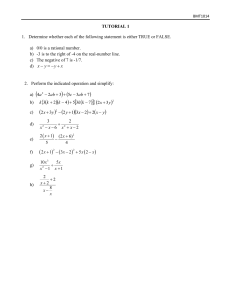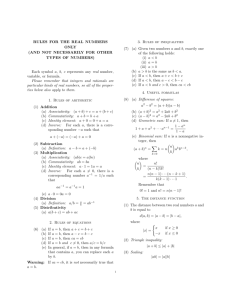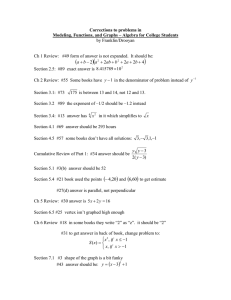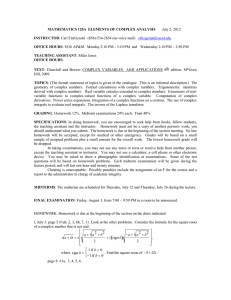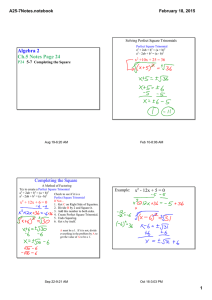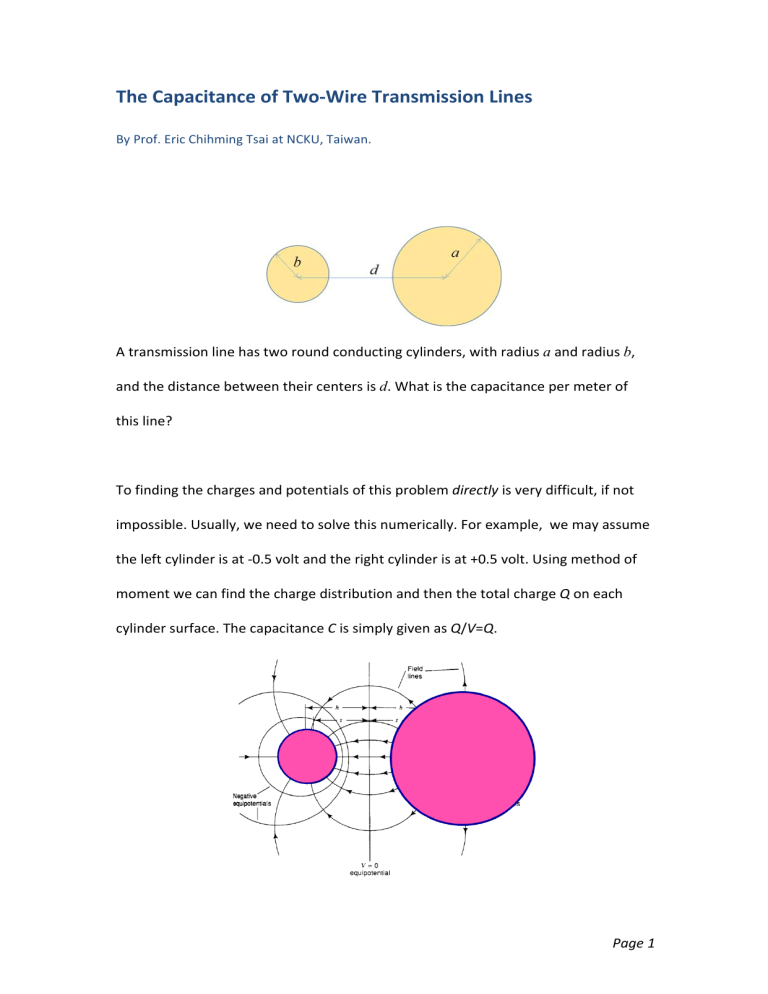
The Capacitance of Two‐Wire Transmission Lines By Prof. Eric Chihming Tsai at NCKU, Taiwan. A transmission line has two round conducting cylinders, with radius a and radius b, and the distance between their centers is d. What is the capacitance per meter of this line? To finding the charges and potentials of this problem directly is very difficult, if not impossible. Usually, we need to solve this numerically. For example, we may assume the left cylinder is at ‐0.5 volt and the right cylinder is at +0.5 volt. Using method of moment we can find the charge distribution and then the total charge Q on each cylinder surface. The capacitance C is simply given as Q/V=Q. Page 1 On the other hand, for this problem we may solve it indirectly by looking at an equivalent problem: the fields of two line charges. This is because when we replace any two equipotential surfaces (the white circles) of the two line charges (the red dots) by two conductors with the same potentials, the fields between the conductors are not changes. And, of course, the two‐line‐charge problem is much easier to analyze. For a line charge L , the potential between 1 and 2 (where is the distance to the line charge) is given by V1 V2 L ln 2 . The 2 1 slide we had discussed in the class and in your notes is shown to the right for your quick reference. Page 2 Now we have two line charges. One positive ( L ) at the right and one negative( L ) at the left. Use the formula in the last paragraph, due to the positive line charge alone the potential VP VO charge the potential VP VO VP VO V L s and due to the negative line ln 2 2 L s ln . Thus the total potential is 2 1 L ln 1 . 2 2 P y 1 L ( x, y ) 2 L O x s s 2 V So we know that for all the points with 1 2 e L K a constant, the potentials are the same. By using simple algebra we can show that these equipotential points form a circle (a cylinder in three dimensions). Because 1 s x 1 K 2 2 y 2 and 2 s x 2 y 2 , thus 2 K2 1 2K s y2 2 x s 2 K 1 K 1 2K s K2 1 2 2 2 x h y , where h s 2 and 2 . K 1 K 1 K2 1 2 s y2 0 x 2xs 2 K 1 2 2 y x O ( h,0) Page 3 Note that the circle is not centered at the line charges. Instead, the center is at h , 0 where h s K2 1 . If V 0 K 1 h 0 , i.e., K2 1 the equipotential surface is on the right half plane. When V goes higher, the circle becomes smaller and its center approaches the positive line charge at s, 0 . When V becomes lower, the circle becomes larger and its center moves away from the positive line charge. When V becomes zero, the radius of the circle is infinite and the center goes to , 0 . This is the y axis (or yz plane in three dimensions). If V 0 1 K 0 h 0 , i.e., the equipotential surface is on the left half plane. When V becomes larger negatively, the radius of the circle becomes smaller, and its center approaches s, 0 . V 20 V 20 V 50 V 100 V 0 V 50 V 100 We can also deduce from above equations that h 2 2 s 2 and K hs hs . Page 4 We now are ready to attack the problem at the begin of this note. How to find the capacitance of this? We have only the parameters a, b, and d, which are all positive. How can we know the locations of the equivalent line charges (the red points)? As we just discussed they are not at the center of any equipotential cylinders. As matter of fact, we don’t even know where to put the origin of the coordinates. In other words, we need to find the invisible s, ha , and hb , from the given a, b, and d. This is the real challenge! For the cylinder on the right (at potential Va 0 ) we have s 2Ka 2Ka K a2 1 , ha a , s a h s K a2 1 K a2 1 K a2 1 2 h a s , and K e L 2 a 2 2 Va h s a a K a 1. ha s a Page 5 For the cylinder on the left (at potential Vb 0 ) we have s 2 Kb 2 Kb K b2 1 s b , h s hb b, K b2 1 K b2 1 K b2 1 2 h b s , and K e L 2 b 2 2 Vb h s b b K b 1. hb s b Thus ha2 a 2 hb2 b 2 s 2 and d ha hb ( hb ha ) a 2 b 2 ha2 hb2 ( ha hb )( ha hb ) d ( ha hb ) ha hb ha a 2 b2 d and ha hb d a 2 b2 d 2 a 2 b2 d 2 and hb . 2 d 2 d So now for given a, b, and d, we know ha and hb . These enable us to locate the origin of the coordinates. Then we know where to put the equivalent line charges by s ha2 a 2 ( a 2 b 2 d 2 ) 2 4a 2 d 2 ( a 2 b 2 d 2 ) 2 4a 2b 2 , 4d 2 4d 2 because ( a 2 b2 d 2 ) 2 ( a 2 b2 d 2 ) 2 4a 2 ( d 2 b2 ) 4a 2d 2 4a 2b2 ( a 2 b 2 d 2 ) 2 4a 2 d 2 ( a 2 b 2 d 2 ) 2 4a 2b 2 . From this we also know 2ds (a 2 b2 d 2 )2 4a 2b2 . We need this later. The potential between the two conductors can now be derived as Va h s L h s ln K a L ln a L ln a and a a Vb L b b ln K b L ln L ln . Thus hb s hb s Page 6 L ( ha s )( hb s ) ln ab L ha hb ( ha hb ) s s 2 L ha2 hb2 ( ha -hb ) 2 2( ha hb ) s 2 s 2 ln ln ab 2ab V Va Vb L ( ha2 s 2 ) ( hb2 s 2 ) ( ha -hb )2 2( ha hb ) s L a 2 b2 d 2 2ds ln ln 2ab 2ab ( a 2 b 2 d 2 ) 2 4a 2b 2 L a 2 b2 d 2 2ds L a 2 b 2 d 2 ln ln 2ab 2ab 2ab 2ab 2 2 2 2 a 2 b2 d 2 L a b2 d 2 1 a b d 1 cosh . L ln 2ab 2ab 2ab 2 So, finally, the capacitance per meter is C Q L V V . 2 2 2 1 a b d cosh 2ab Note that since the two conductors are on the different sides of the yz plane, they do not touch each other. We have the condition (a b) d implied. This also means ( a 2 b2 ) ( a b) 2 d 2 . Therefore, the argument of cosh 1 is positive. For the special case when a b , we find ha hb h, d ha hb 2h s ( a 2 b 2 d 2 ) 2 4a 2b 2 (2 2 4h 2 ) 2 4 4 16h 4 16h 2 2 h2 2 2d 4h 4h L d 2 a 2 b2 2ds L 2h 2 2 2h h 2 2 V ln ln 2 2ab L ln C L V h h2 2 2 2 h h h L ln 12 L cosh 1 2 cosh 1 h / This is exactly what we have in the class. Page 7 What if the two equipotential surfaces are one the same side of the yz plane? It is certainly possible. Let’s increase the Vb such that Va Vb 0 . It looks like this: You can verify that the derivations are just the same. All the equations are still correct if “ ” signs are changed to “ ” and “ ” signs are changed to “ ”. Thus the final result is C . 2 2 2 1 a b d cosh 2ab Obviously, (b a ) d , a 2 b 2 (b a ) 2 d 2 , and the argument of cosh 1 is positive. Page 8 This structure is similar to a coaxial transmission line. Only now that it is not really “coaxial”. As matter of fact, if we let d a and d b 2 2 2 a b d a 2 b2 cosh 1 cosh 1 2ab 2ab 2 2 a 2 2 a 2 b2 a 2 b 2 ln a b2 a b2 ln ln 1 b 2ab 2ab 2ab 2ab C This is the capacitance of a coaxial transmission line! On the other hand, if the center conductor of a coaxial line is off‐center, we may use the formula at the end of the last page to evaluate the effect on its capacitance. For example, the capacitance deviation is analyzed for a coaxial line with b / a 7 / 3 . The result shows that for a 20% off center, the capacitance increases only about 1%. This is very stable engineering design! Can you explain why it works so well? Page 9
